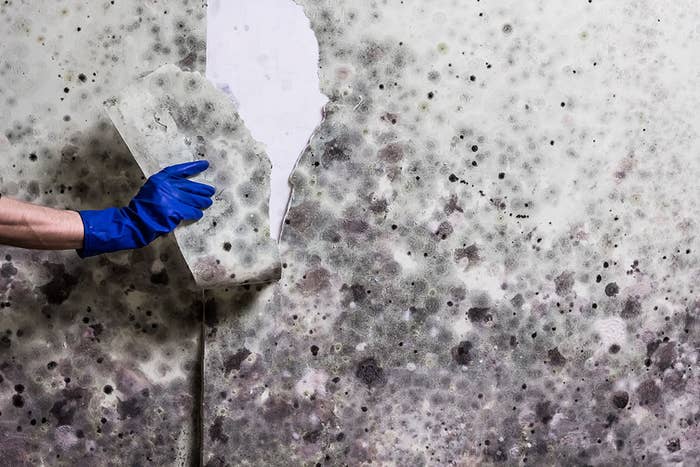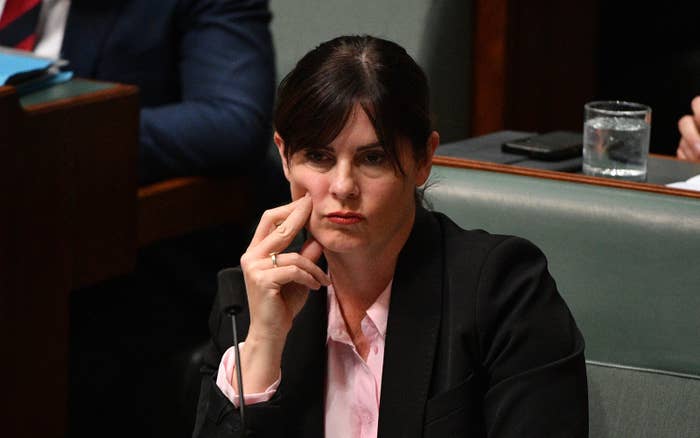
For Jodie, it started with hay.
About four years ago, around the same time Jodie, her husband and their three young children moved into an old house built on a slab of rock, the 48-year-old Sydneysider spent a day baling hay at a farm with friends.
“I was breathing in hay, it was in my hair, my clothes, my mouth,” she told BuzzFeed News. “It was that particular day I think my genetics turned on.”
After the day at the farm Jodie (who asked to withhold her surname) started to get allergy symptoms that seemed to be set off by dust, mould and pollen.
There were heavy rains the following March. “My shoulders stopped working,” Jodie said. “I couldn’t lift my arm, I couldn’t turn over in bed, I couldn’t lift my kids, I couldn’t close the boot of my car.”
The problem spread from her right shoulder across the middle of her back into her left shoulder, and she saw a physiotherapist, but the problem didn’t go away. Eventually, she was unable to move her neck, shoulders and back. It stayed that way for more than two years.
At times, the stiffness would ease, and then worsen. “Now I look back, and it was very much seasonal depending on what was happening with the mould,” Jodie said.
Other symptoms developed: her hair began falling out, she couldn’t stay awake, her short-term memory and eyesight were failing, she had constant static shock, and foods she used to eat would give her sudden diarrhoea.
“I was drinking a Red Bull when I got up every morning just so I could get my kids safely to school without falling asleep, and then another one before pick up,” she said. “I would run into friends and I couldn’t remember their names.”
“Massive” anxiety followed: “I couldn’t stop clenching my teeth. I had massive dark thoughts about death all the time, and I had never been someone to go near death or anxiety.”
At first, she didn’t think to connect the dots between these symptoms. Jodie says she was too busy to think much about herself. “I just thought, I’ve got three young kids, I’m exhausted, I’m 45 years old.”
She started seeing doctors and having MRIs, blood tests and biopsies. All the tests came back with normal results. Some doctors told her she must have a post-viral inflammation. However that didn’t make sense to Jodie — she hadn’t had a virus, she had been completely healthy.
Others told her it was all in her head, and that she needed antidepressants. This was “absolutely devastating”. “I would get in my car and just sob,” she said. “I would ring my husband and say, ‘I’ve got another doctor that won’t believe me, I am not making this up’.”
After an overseas trip, her symptoms improved, but then the March rains came again and Jodie says she “hit rock bottom”.
One day, the house was smelling particularly bad. The cellar underneath was particularly damp when it rained, and mould flourished. “I was like, ‘This house stinks. The mould is –’, and I went to say ‘killing me’. And then I said, ‘Oh my god, this has got to be it’.”
Until that point, married to a specialist doctor, Jodie had avoided googling her symptoms. But then she typed it in – mould + illness.
“Then my internet exploded,” she said.
That’s how Jodie learnt about Chronic Inflammatory Response Syndrome (CIRS) – also known as sick building syndrome or mould-related illness – which is currently being investigated by a federal parliamentary committee.
CIRS is described as a chronic illness that can develop in response to water-damaged buildings that host mould or other microbes. Its proponents say that symptoms can include chronic fatigue, headaches, muscle pain, irritable bowel syndrome, neurological symptoms and Multiple Chemical Sensitivity.
CIRS advocates say the symptoms can persist for years, even if a person is no longer exposed to the mould. This is especially so in those who have a genetic predisposition, estimated to be one in four. The theory is that a significant event like a car accident or childbirth can trigger this predisposition, and then people can become sick quite quickly after being exposed to toxins.
But most doctors don’t recognise CIRS. In a 3,400-person strong Facebook group for sufferers and “mould warriors”, Toxic Mould Support Australia, members seek and swap recommendations for CIRS-sympathetic or “mould literate” doctors, and complain about bad experiences.
While it’s accepted that mould can cause allergies and asthma, “this syndrome is not generally recognised by the medical community”, Dr Ian Musgrave, a pharmacology professor at the University of Adelaide, told BuzzFeed News. He says studies of populations exposed to mould after floods don’t support the CIRS hypothesis.

Among the Facebook group’s members is a federal politician, Lucy Wicks, the Liberal member for Robertson on the NSW Central Coast. Wicks told The Daily Telegraph last year that after a huge tree fell onto her home during a 2015 storm she started to suffer chest infections, chronic fatigue and memory lapses. Visits to then prime minister Malcolm Turnbull’s office left her feverish and stammering.
“Every time I would go to a building, I would get sick,” she said.
Earlier this year, Wicks told Nine News that her family had sold their home and moved more than a dozen times in 16 months in order to find a mould-free home.
“When you walk into a building and you have to leave 15 minutes later because your skin is on fire, your brain feels like mush, and you know that within two hours you are going to be flat on your back, unable to get out of bed for some hours, it is very, very real and it is not just happening to me, it’s happening to a lot of people around Australia,” Wicks said.
Wicks, who was unavailable for an interview, called for an inquiry into the disease, and in June a federal parliamentary committee announced it would look into illnesses caused by water-damaged buildings, including CIRS.
The inquiry has received over 140 submissions, many written by people who say they have CIRS.
In a hearing earlier this month, the Health Department told the inquiry there isn’t sufficient evidence to prove a link between mould and the disease. Australia’s chief medical officer, professor Brendan Murphy, noted “the nature of [the disease] itself is also somewhat disputed”, but added there was also no evidence to disprove the link.
Professor Murphy described the department’s “very first priority” as making sure that “people don’t latch on to a diagnosis because their symptom complexes match what’s on a website or a list” and that they have a proper comprehensive assessment, because there could be multiple causes for the symptoms.
He also called on the medical profession to be more sympathetic. “They've tended to say, 'This disease doesn't exist' and therefore they've downplayed or belittled the symptoms,” Murphy said. “We are very strongly of the view that these symptoms are absolutely genuine, serious and debilitating, and need to be taken seriously.”
Jodie estimates she’s spent $50,000 on her illness in the last year, including making adjustments to her home, sending her blood to America for tests and buying medical supplements. She’s bought an infra-red sauna and a water filtration system, and she and her husband have engaged building biologists to help them design their renovations to protect the house from mould.
The $50,000 doesn’t include the organic food that she now sticks to. She also skips gluten, dairy, soy, sugar, corn, nuts, mushrooms, tinned tomatoes, caffeine and alcohol.
Jodie starts each day with two hours of treatment, including injections in her stomach. Throughout the day, she has to use two nasal sprays four times each, she takes 20 tablets a day, and puts things “where the sun don’t shine”. She describes her treatment as a full-time job.
But what seems to upset her more than the expense and time is the lack of acceptance for her diagnosis from the medical profession, family and friends.
“It’s been the loneliest journey,” Jodie said. “If you get a cancer diagnosis, you’ve got food drop-offs and kid pick-ups.” But with CIRS, “no-one even checks in, no-one even asks how I am. It’s like this invisible thing that you’ve got. I don’t think anyone really believes that you are as sick as you are.”
The inquiry is due to deliver its report in October, and Jodie hopes it will lead to new recognition for CIRS. She wants it to be acknowledged as a disease, and for testing and treatment to become more available in Australia.
“I definitely feel like it’s gaining traction and momentum,” Jodie said. “I am so hopeful.”
If you need to talk to someone, you can call Lifeline Australia on 13 11 14 or Beyond Blue Australia on 1300 224 636.
